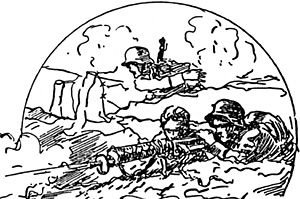 First off, the Germans didn’t call their new techniques “Infiltration Tactics.” They didn’t specifically call them anything in particular. The Army High Command (Oberste Heeresleitung, or OHL) was particularly adept at searching for new tactical techniques to break the stalemate of the trenches. Always open to innovations, several interesting ideas converged into a tactical offensive system and were published on 1 January 1918 as “The Attack in Position Warfare.” This new doctrine was misidentified by the Allies and given the name “Hutier Tactics” after the general who used infiltration techniques with some success at Riga on the eastern front. However, the term infiltration perhaps is descriptive of a combination of infantry and artillery techniques which were united into a new offensive doctrine.
First off, the Germans didn’t call their new techniques “Infiltration Tactics.” They didn’t specifically call them anything in particular. The Army High Command (Oberste Heeresleitung, or OHL) was particularly adept at searching for new tactical techniques to break the stalemate of the trenches. Always open to innovations, several interesting ideas converged into a tactical offensive system and were published on 1 January 1918 as “The Attack in Position Warfare.” This new doctrine was misidentified by the Allies and given the name “Hutier Tactics” after the general who used infiltration techniques with some success at Riga on the eastern front. However, the term infiltration perhaps is descriptive of a combination of infantry and artillery techniques which were united into a new offensive doctrine.
Probably the prototype for the storm trooper unit was Willy Rohr’s Sturmbattallion. Rohr organized the basic element of maneuver at the squad level. The Stosstrupp (assault squad) or Sturmtrupp (storm squad) was designed to act more or less independently and to drive deeply into the enemy position and envelop strong points from the flank or rear. The battalion armed itself with a wide variety of weapons: rifles, light and heavy machine guns, grenades, flame throwers, trench mortars and even light artillery pieces. A key element in Rohr’s success was the close cooperation of artillery support. As Sturmbatallion Rohr gained fame, it came to the attention of the High Command. Soon, Rohr’s men were the training cadres for schools behind the lines in which their techniques were imparted upon a much wider audience.
When the OHL decided to go onto the offensive in 1918, it needed large numbers of storm battalions. However, it was clear that German industry could not produce the numbers of weapons necessary to re-equip the entire force. Instead, OHL designated 56 of the 192 divisions on the western front as attack divisions (angriffsdivisionen or stossdivisionen). The rest were called trench divisions who would hold the line elsewhere while the great offensives struck in several locations in the north. Even within an attack division, not all troops were trained or equipped as storm battalions. In fact, most were not. And the storm battalions themselves had several different organizations, depending on availability of equipment and the time they were formed.
Typically, storm battalions consisted of a small number of storm companies, a machine gun company, an artillery battery of light guns, and flame thrower and trench mortar sections. Within the storm companies, each squad was formed around a light machinegun and several riflemen. The function of the riflemen was to protect the light machinegun crew and to facilitate its forward movement.
Artillery Support in the Attack
An essential and sometimes overlooked aspect of infiltration tactics is the close artillery support which enables the infantry to keep moving deeper and deeper into enemy lines. At this time in artillery development, it was considered essential that guns be registered prior to firing a mission. Basically, once a battery moved into a firing location, at least one gun fired upon a known target. The data gathered provided a corrective to the ballistic solution generated on paper only. Unfortunately, this tipped off the enemy when several guns across the front were registered. Could an attack be far behind? A German artillery captain had the temerity to challenge this honored procedure. He developed a way of taking precise measurements by test firing each individual gun while it was well behind friendly lines. Thus, the battery could secretly move to a concealed firing position during the night. If the precise location of the firing point was known and that of the target, then pretty accurate fires could be achieved without the tell-tale registration. Target locations deep in enemy lines were located by aerial photography. Thus, artillery could deliver effective fire throughout the depth of the enemy’s defenses to neutralize forces, seal off the attack corridor, disrupt command centers, and knock out the enemy’s artillery.
Modern military buffs question why the Germans did not manufacture more tanks, particularly after the benefits had been amply demonstrated to the detriment of the Germans. OHL (Erich Ludendorff actually) decided to devote only minimal resources to tank development. Resources were scarce and the Army High Command decided that a better benefit would be derived by producing more trucks. Motor transport moved ammunition and supplies from the railheads to the troops and thus were critical in supporting an offensive. OHL believed it had a means of breaking through the enemy defensive zone. What it needed was the means of moving and sustaining the forces that would exploit the breakthrough. This meant large numbers of trucks. Anyway, by 1918 the Germans had issued anti-tank rifles and had developed adequate anti-tank tactics that limited the amount of damage that the Allied tanks could inflict.
More World War I German Infiltration Tactics
-
Introduction
Infiltration Tactics
Infiltration in Action
Solo Play
Artillery
How to Use Storm Troops
Large Scenario Map (slow: 100K)
Back to Table of Contents -- Lone Warrior #135
Back to Lone Warrior List of Issues
Back to MagWeb Magazine List
© Copyright 2001 by Solo Wargamers Association.
This article appears in MagWeb (Magazine Web) on the Internet World Wide Web.
Other military history articles and gaming articles are available at http://www.magweb.com
